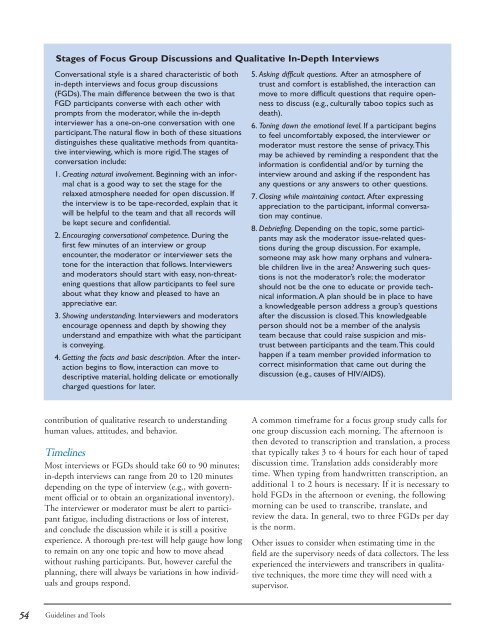Conducting a Participatory Situation Analysis of.pdf - Global HIV ...
Conducting a Participatory Situation Analysis of.pdf - Global HIV ...
Conducting a Participatory Situation Analysis of.pdf - Global HIV ...
Create successful ePaper yourself
Turn your PDF publications into a flip-book with our unique Google optimized e-Paper software.
Stages <strong>of</strong> Focus Group Discussions and Qualitative In-Depth Interviews<br />
Conversational style is a shared characteristic <strong>of</strong> both<br />
in-depth interviews and focus group discussions<br />
(FGDs).The main difference between the two is that<br />
FGD participants converse with each other with<br />
prompts from the moderator, while the in-depth<br />
interviewer has a one-on-one conversation with one<br />
participant.The natural flow in both <strong>of</strong> these situations<br />
distinguishes these qualitative methods from quantitative<br />
interviewing, which is more rigid.The stages <strong>of</strong><br />
conversation include:<br />
1. Creating natural involvement. Beginning with an informal<br />
chat is a good way to set the stage for the<br />
relaxed atmosphere needed for open discussion. If<br />
the interview is to be tape-recorded, explain that it<br />
will be helpful to the team and that all records will<br />
be kept secure and confidential.<br />
2. Encouraging conversational competence. During the<br />
first few minutes <strong>of</strong> an interview or group<br />
encounter, the moderator or interviewer sets the<br />
tone for the interaction that follows. Interviewers<br />
and moderators should start with easy, non-threatening<br />
questions that allow participants to feel sure<br />
about what they know and pleased to have an<br />
appreciative ear.<br />
3. Showing understanding. Interviewers and moderators<br />
encourage openness and depth by showing they<br />
understand and empathize with what the participant<br />
is conveying.<br />
4. Getting the facts and basic description. After the interaction<br />
begins to flow, interaction can move to<br />
descriptive material, holding delicate or emotionally<br />
charged questions for later.<br />
5. Asking difficult questions. After an atmosphere <strong>of</strong><br />
trust and comfort is established, the interaction can<br />
move to more difficult questions that require openness<br />
to discuss (e.g., culturally taboo topics such as<br />
death).<br />
6. Toning down the emotional level. If a participant begins<br />
to feel uncomfortably exposed, the interviewer or<br />
moderator must restore the sense <strong>of</strong> privacy.This<br />
may be achieved by reminding a respondent that the<br />
information is confidential and/or by turning the<br />
interview around and asking if the respondent has<br />
any questions or any answers to other questions.<br />
7. Closing while maintaining contact. After expressing<br />
appreciation to the participant, informal conversation<br />
may continue.<br />
8. Debriefing. Depending on the topic, some participants<br />
may ask the moderator issue-related questions<br />
during the group discussion. For example,<br />
someone may ask how many orphans and vulnerable<br />
children live in the area? Answering such questions<br />
is not the moderator’s role; the moderator<br />
should not be the one to educate or provide technical<br />
information.A plan should be in place to have<br />
a knowledgeable person address a group’s questions<br />
after the discussion is closed.This knowledgeable<br />
person should not be a member <strong>of</strong> the analysis<br />
team because that could raise suspicion and mistrust<br />
between participants and the team.This could<br />
happen if a team member provided information to<br />
correct misinformation that came out during the<br />
discussion (e.g., causes <strong>of</strong> <strong>HIV</strong>/AIDS).<br />
contribution <strong>of</strong> qualitative research to understanding<br />
human values, attitudes, and behavior.<br />
Timelines<br />
Most interviews or FGDs should take 60 to 90 minutes;<br />
in-depth interviews can range from 20 to 120 minutes<br />
depending on the type <strong>of</strong> interview (e.g., with government<br />
<strong>of</strong>ficial or to obtain an organizational inventory).<br />
The interviewer or moderator must be alert to participant<br />
fatigue, including distractions or loss <strong>of</strong> interest,<br />
and conclude the discussion while it is still a positive<br />
experience. A thorough pre-test will help gauge how long<br />
to remain on any one topic and how to move ahead<br />
without rushing participants. But, however careful the<br />
planning, there will always be variations in how individuals<br />
and groups respond.<br />
A common timeframe for a focus group study calls for<br />
one group discussion each morning. The afternoon is<br />
then devoted to transcription and translation, a process<br />
that typically takes 3 to 4 hours for each hour <strong>of</strong> taped<br />
discussion time. Translation adds considerably more<br />
time. When typing from handwritten transcription, an<br />
additional 1 to 2 hours is necessary. If it is necessary to<br />
hold FGDs in the afternoon or evening, the following<br />
morning can be used to transcribe, translate, and<br />
review the data. In general, two to three FGDs per day<br />
is the norm.<br />
Other issues to consider when estimating time in the<br />
field are the supervisory needs <strong>of</strong> data collectors. The less<br />
experienced the interviewers and transcribers in qualitative<br />
techniques, the more time they will need with a<br />
supervisor.<br />
54<br />
Guidelines and Tools















